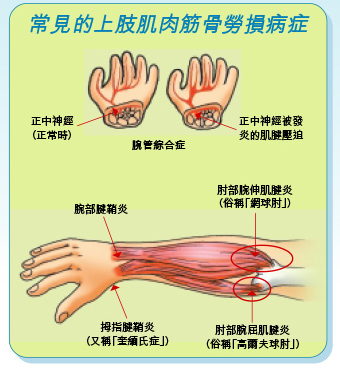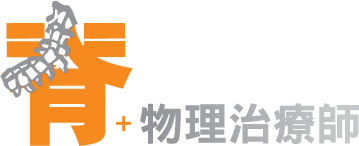What is Repetitive Strain Injury (RSI)?
As more and more work, education and recreation involves computers, everyone needs to be aware of the hazard of Repetitive Strain Injury (RSI) to the hands very painful condition that is far easier to prevent than to cure once contracted, and can occur even in young physically fit people.
What is Repetitive Strain Injury (RSI)?
RSI is caused by mechanical irritation which upsets the body’s highly turned natural balance. It is an inflammation of the tendon sheaths in the finger and hands, wrists, and elbows which may eventually progress to the upper arms and shoulders. Repeated physical movements cause damage to tendons, nerves, muscles, and other soft body tissues.
Often stiffness in the spinal joints of the neck and upper back aggravate or even cause RSI in the arms and hands. Spinal problems cause irritation of the nerves as they exit the spine and this leads to problems in the muscles they supply.
 |
圖一:常見的上肢肌肉筋骨勞損病症 |
What are the symptoms?
1. Tightness, discomfort, stiffness, or pain in the hands, wrists, fingers, forearms or elbows.
2. Tingling, coldness, or numbness in the hands.
3. Clumsiness or loss of hand strength and coordination.
4. Pain that wakes you up in the night.
5. Feeling a need to massage your hands, wrists and arms.
What are the symptoms?
1. Don’t pound on the keys: use light touch.
2. Take lots of breaks to stretch and relax. This means both short breaks every few minutes and longer breaks every hour or so.
3. Eliminate unnecessary computer usage. No amounts of ergonomic changes, fancy keyboards, or exercises are going to help if you are simply typing more than your body can handle.
4. Consider voice recognition. Software that allows computer control or full voice dictation is becoming more powerful and less expensive.
5. Evaluate other activities. Sports, carrying children, hobbies requiring intense small work (like knitting), and excess effort/tension in other daily things may have enormous impact too.
6. Pay attention to your body. Pain is your body telling you that it’s in big trouble, but learning what is comfortable or awkward for your body before your in pain may prevent injury.
7. Kids are at risk too: increasing hours in front of the computer at home and school, using equipment that is not set up correctly for their size.
What are the prevention and treatments?
1. Prevention is still the best prescription. Wrist splint, arm rest, split keyboard, spinal adjustment, etc. is going to permit an immediate return to work at full speed if you are injured. It is important to make the long term changes in technique and work habits that initially caused the complaint.
2. Chiropractic adjustment, infrared, shockwave, interferential therapy can help to restore full motion, reducing stress on the nearby muscles, tendons and nerves.



